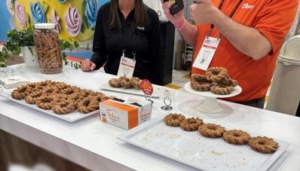At a Glance
- 2025 IBIE takeaways focus on viability, not flash: Leaders are tackling labor shortages, sustainability demands, consumer shifts, and thin margins.
- Sustainability pays off: Progress over perfection, with tools like shelf-life extension and waste heat recovery turning costs into real returns.
- Packaging and innovation are profit drivers: Smart packaging, AI forecasting, and predictive systems cut waste and boost efficiency.
- Winners act fast: Companies testing and scaling now are pulling ahead, while those who wait risk higher costs and lost customers.
Cards on the Table
This is a first for Inline Plastics’ Learning Center — I’m stepping out and speaking to you directly.
Hi, I’m Mark, Content Manager at Inline. I came into this role from outside the packaging world, but now I spend my days in a tamper-protected office, at a shelf-stable desk, sipping from my leak-resistant mug.
So, when I was sent to IBIE — the International Baking Industry Exposition in Las Vegas, the world’s largest and most well-attended baking show — I had two questions: “How many pastries can I eat in one sitting?” and “How can I make this useful?” After all, I’m not a baker, I don’t work in sales, and I don’t know how to run a booth.
What I can do — and what I love to do — is learn (humble brag). So, I developed a strategy and explored free sessions on seven key areas that food pros care about most: sustainability, packaging, consumer trends, industry outlook, innovation, automation, and implementation.
Here’s the issue: Many leaders are drawn to new equipment or ingredients. Yet, the real conversations focus on resilience. This involves labor shortages, sustainability concerns, evolving consumer expectations, and narrow profit margins. Those who adapt are turning these challenges into advantages. Those who don’t are watching costs climb and customers drift away.
As an outsider, I could see patterns industry veterans might miss. I learned this so you didn’t have to. What I uncovered were seven practical areas where leaders are acting now — not with magic bullets, but with smart, focused moves.
So, without further ado, let me show my hand on what I discovered (yes, that’s a Vegas pun — and no, I’m not sorry).
The Sustainability Revolution Isn’t Coming — It’s Here
 Forget everything you think you know about sustainability being expensive or complicated. The most successful food companies at IBIE had cracked a simple code: Make sustainability profitable, not painful.
Forget everything you think you know about sustainability being expensive or complicated. The most successful food companies at IBIE had cracked a simple code: Make sustainability profitable, not painful.
“Perfect is the enemy of good,” as one sustainability expert put it. Too many companies spin their wheels chasing flawless eco-friendly solutions and overlook practical steps that deliver real impact right now. The most successful leaders use “Even Over” frameworks to guide tough choices — like valuing community pride even over cost savings, or customer trust even over short-term profits. These aren’t theoretical trade-offs; they’re strategies that turn sustainability into a profit driver. By focusing on progress instead of perfection, companies cut waste, build loyalty, and gain an edge while competitors stall.
But here’s the twist: Those trade-offs are creating real financial returns. Innovative waste heat recovery systems — equipment that captures and reuses heat that would otherwise be lost during baking — are saving bakeries thousands of dollars — one speaker noted $160,000 annually in fuel costs. A food science researcher at Innophos demonstrated how advanced shelf-life extension technologies in ingredients can cut carbon footprints by up to 18% while addressing what industry data shows is $28.7 billion in annual food waste at retail and consumer levels.
The breakthrough isn’t in finding perfect solutions — it’s in systems thinking that turns sustainability investments into profit centers.
Packaging Innovation Is Solving Problems You Didn’t Know You Had
The packaging sessions revealed something surprising: The biggest innovations aren’t about materials — they’re about intelligence.
Smart packaging with QR codes, temperature sensors, and supply chain tracking is doing more than satisfying curious consumers. It’s providing real-time data that prevents spoilage, reduces returns, and optimizes distribution routes. One bakery reduced product losses significantly by simply identifying when and where temperature breaks occurred.
Materials science is advancing, too, but not in the way you’d expect. The winners aren’t choosing paper over plastic or biodegradable over traditional. They are conducting rigorous tests that strike a balance between sustainability and functionality. This way, new materials will not negatively affect shelf life or alter flavors.
The companies getting this right are treating packaging as a profit center, not a cost center.
Consumer Trends Are Rewriting the Playbook
 If you’re still targeting Baby Boomers as your growth engine, you’re fighting yesterday’s war (Sorry, Dad, I know your opinions matter). Millennials (that’s me) are now the most significant portion of grocery growth, and we’re bringing Gen Z along for the ride.
If you’re still targeting Baby Boomers as your growth engine, you’re fighting yesterday’s war (Sorry, Dad, I know your opinions matter). Millennials (that’s me) are now the most significant portion of grocery growth, and we’re bringing Gen Z along for the ride.
However, the consumer research revealed something more significant: These aren’t just different age groups — they’re entirely different consumers, according to data from Puratos USA. “Variety Seekers” crave global flavors and novelty. “Health Hunters” demand transparency and functional benefits. “Flavor-Firsts” will pay premium prices, but only for genuine indulgence.
The winning strategy isn’t trying to please everyone — it’s picking your consumer segment and delivering exactly what they value most. Companies succeeding with “Health Hunters” are leveraging gut health and clean labels. Those targeting “Variety Seekers” are experimenting with Asian-inspired donuts and alternative pizza crusts.
Ninety-four percent of consumers are willing to splurge on baked goods, despite inflation. They’re not seeking deals. Instead, they want products that match their values and desires. This is especially true for “better-for-you” treats, according to the American Bakers Association.
The Industry Is Stronger Than the Headlines Suggest
Despite all the challenges, 83% of retail bakery professionals are “somewhat or very positive” about their 2025 outlook, according to data by Cypress Research for Bake Magazine. That’s not blind optimism — it’s informed confidence based on real opportunities.
Labor shortages are forcing bakeries to invest in automation. This helps them work faster and more consistently. At the same time, inflation is encouraging a shift toward premium products that deliver more substantial margins. As consumers look for better-for-you options, bakeries are getting creative. They’re offering distinct products that can command higher prices.
Successful companies are not merely getting through challenges; they are overcoming them. They are using these challenges as chances to create stronger and more profitable operations.
Innovation Is Moving Beyond Ingredients to Systems
 The most compelling innovations at IBIE weren’t about new flavors or formulations (though my tummy would beg to differ) — they were about solving systemic problems.
The most compelling innovations at IBIE weren’t about new flavors or formulations (though my tummy would beg to differ) — they were about solving systemic problems.
The aforementioned innovations — from shelf-life extension to waste heat recovery — demonstrate how efficiency and sustainability can be combined. Additionally, AI-driven forecasting helps eliminate the guesswork that can lead to costly overproduction.
The key insight: Innovation works best when it addresses business problems, not just consumer desires. Technologies that are gaining traction show clear ROI. They do this by reducing waste, cutting energy costs, or improving product quality.
Automation Is (And Has Been) Ready for Food Manufacturing
The automation discussion has shifted from “Should we?” to “How fast can we?”
However, the real story isn’t about robots replacing humans — it’s about intelligent systems amplifying human capabilities. AI-driven forecasting improves accuracy while reducing manual planning time. Robotic picking systems free drivers to focus on sales and customer relationships. Predictive maintenance prevents costly breakdowns before they happen.
Additionally, acceptance rates for AI are at an all-time high. According to data gathered from a recent Slack study on Salesforce, “81% of employees are more satisfied with their job than colleagues not using AI.”
The Practical Path Forward Is Clearer Than Ever
The companies winning today aren’t the biggest — they’re the ones moving fastest on their priorities.
Instead of jumping straight to solutions, start with an honest assessment. Run small, scalable pilots and track what really matters, such as cutting waste rather than chasing scores and keeping customers rather than only chasing new ones.
Businesses that act now — balancing sustainability with smart automation — are setting themselves up to lead. Those who wait will see shrinking margins while competitors gain efficiency.
Pick one area where you can make an immediate impact. The key is to act now, rather than waiting for perfect conditions.
The Gamble That Paid Off
 Beyond all the industry insights, I learned some practical lessons that didn’t make it into the session notes. Wear comfortable shoes — you’ll walk miles between expo halls. Always sit in the front row so you can be the first to talk to speakers afterward (that’s where the real takeaways happen). And Vegas taught me that knowing when to walk away is just as important as knowing when to bet.
Beyond all the industry insights, I learned some practical lessons that didn’t make it into the session notes. Wear comfortable shoes — you’ll walk miles between expo halls. Always sit in the front row so you can be the first to talk to speakers afterward (that’s where the real takeaways happen). And Vegas taught me that knowing when to walk away is just as important as knowing when to bet.
The show was genuinely fun, and I learned more about the baking industry in three days than I thought possible. Now I have plenty of material to bring back to Inline Plastics’ Learning Center — and hopefully some insights that will help you navigate whatever challenges your food business is facing.
Sometimes the best education comes from stepping outside your comfort zone and admitting you don’t know everything. I mean, who knew a relatively new packaging guy could find so much value in a baking expo?
Are you interested in discovering more about packaging solutions? Visit our Learning Center today and explore a wide range of topics.

